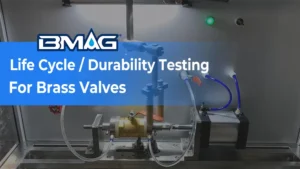Hay muchos tipos de válvulas de bloqueo, y la principal diferencia entre ellos radica en sus mecanismos de bloqueo y métodos de operación únicos.
Tabla de contenido
PalancaWhat does a lockable valve do?
Simply put, a lockable valve is a valve that can be secured in the “open” o “closed” position using a physical mechanism to prevent unauthorized operation. Its core functions arelocking and controlling access.
The Most Important Thing for a Locking Valve: Resistance to Brute Force and Tampering
- Resistance to Technical Bypass
The lock mechanism must be non-standard and difficult to duplicate. This is the core advantage of magnetic and proprietary mechanical keys—they lack a traditional keyhole, making technical bypass methods like lock picking virtually impossible for a potential thief. - Resistance to Brute Force Attack
The valve body and its internal locking mechanism must be robust enough to withstand forceful attacks from common tools like hammers and pipe wrenches. A design where critical components are concealed internally, leaving no external weak points, is essential for this level of security.
The Second Important Thing for a Locking Valve: Reliability of Lockable Ball Valve
A reliable brass locking ball valve is one you can depend on to function correctly every time. This reliability is built on several key factors:
- Durability of Materials
A reliable brass locking valve must be constructed from high-grade, durable materials that resist corrosion (rust) and fracture under stress. The quality of the materials directly impacts the valve’s lifespan and its ability to perform its security function. - Intelligent Design
The valve’s lock internal design must be both effective and logical, ensuring that its moving parts operate smoothly without jamming or premature wear. A well-designed mechanism demonstrates high operational integrity over thousands of cycles of use. - Manufacturing Precision
Every component of the valve must be manufactured to exact specifications. High precision ensures that all parts fit together perfectly, which is critical for the lock to engage and disengage reliably every time. - Environmental Durability
Since these valves are often installed outdoors, they must be engineered to endure harsh environmental conditions, including rain, dust, freezing temperatures, and corrosive elements. A lock that fails due to rust or ice is no more effective than having no lock at all.
What Makes A Locking Valve Stand Out From The Rest?
The answer is intelligent design that delivers real-world benefits to you. A better design for the lockable ball valves means you get enhanced security, effortless operation, more flexible installation space, and a more rentable solution. Al final, great design serves your safety, your efficiency, and your budget.
Hoy, we will focus specifically on theProprietary Key-Operated Brass Locking Valve.
BW-L02D Angle Type Lockable Valve with Spline Structure

BW-L02D Angle Lockable Valve with Spline Structure
- Overall Form: T-Handle Design
- Función: The key features a classic T-handle structure. This ergonomic design allows the operator to grip it firmly with one hand, enabling effortless and precise control when opening or closing the valve.
- Core Mechanism: Internal Spline Socket
- Descripción: This feature is central to the key’s security. The end of the key’s main shaft contains a hollow, cylindrical socket. Its inner wall is machined with a series of precise, equally spaced longitudinal grooves (splines), featuring a total of 18 teeth.

Latón Valve Body Lock Structure
- Protective Design: The lock core on the valve body is completely encircled by a robust, cylindrical shroud. This design leaves minimal operating space around the valve stem, effectively preventing standard tools like pliers from gripping or turning the core, thus providing excellent resistance to tampering and brute force attacks.
Brass Locking Valve Matching Principle & Ventajas
- Matching Principle: The key’s “female” spline socket—with its specific shape, tamaño, and 18-tooth pattern—is engineered to precisely match the “male” splined stem on the valve. This multi-toothed engagement design offers two core advantages:
- High Security: Only a key with the perfectly matching internal spline pattern can engage and turn the valve stem. This eliminates the possibility of unauthorized operation using standard tools like screwdrivers, wrenches, or pliers.
- Efficient Torque Transfer: Compared to single-point interfaces like a square or hexagon, the spline structure provides multiple points of contact. This distributes rotational force evenly across the valve stem, preventing slipping or stripping during torque application and ensuring long-term operational reliability.
BW-L36 Lockable Valve with Spring-Loaded Expanding Claw Key Structure

This is a high-security proprietary key featuring a unique mechanical linkage system for lock valves.
- Spring-Loaded, Push-to-Engage Action:
The key integrates an internal spring mechanism. To operate, the user must first press the T-handle vertically downwards against the spring’s preload to activate the locking function. - Expandable Dual-Claw Chuck:
When the handle is depressed, the internal mechanism drives two semi-circular “claws” at the key’s tip to expand outwards. The shape and size of these expanded claws are precisely engineered to perfectly grip the recessed hexagonal section of the security bolt inside the valve body. - Heavy-Duty T-Handle and Shroud Design:
The key is equipped with an ergonomic T-handle for easy application of force, and its main body acts as a robust metal shroud, providing excellent protection for the precise internal linkage components.

Dual-Structure, Tamper-Proof Bolt
The matching security bolt is the other half of this security system, designed to defeat all standard tools.
- Circular Protective Head:
The top of the bolt is a smooth, round surface with no edges for a wrench or pliers to grip. It acts as a shield, completely covering and protecting the hexagonal structure beneath it. - Recessed Hexagonal Bolt Body:
The actual hexagonal bolt structure is “hidden” beneath the circular head, creating a recessed area. Any standard socket or wrench is physically blocked by the round head and cannot access this hexagonal section.
Operating Principle & Core Security Advantages
The system’s security is derived from the unique, synergistic interaction between the key and the bolt.
- Operating Procedure:
- The key’s shroud is aligned and placed over the bolt’s circular head.
- The T-handle is pressed down firmly, causing the key’s internal claws to expand and securely engage the recessed hexagonal bolt body.
- With the key and bolt now rigidly connected, rotating the T-handle allows the bolt to be easily screwed in or out.
- Summary of Security Advantages:
- Unique Engagement Mechanism: El “push-to-expand” mechanical action cannot be replicated by any standard tool, fundamentally preventing technical bypass.
- Dual Physical Protection: The combination of the circular protective head and the recessed hexagonal body defeats both brute-force gripping tools and standard sockets simultaneously.
- System Exclusivity: Only this proprietary key can match and operate the corresponding security bolt, creating a highly exclusive, closed-loop security system.
Let’s take a look at the traditional padlock válvula.
Locking Handle Brass Ball Valve
1. Definition of Locking Handle Brass Ball Valve
A Ball Valve with an Integrated Sliding Lock Latch is a type of ball valve that features a specific mechanical locking mechanism built directly into its operating handle. It utilizes a clever sliding lock latch that works in coordination with a stop lug on the valve body. This assembly is then secured by an external padlock to achieve a reliable lockout of the valve’s operating state. This design incorporates the locking function into the valve itself, eliminating the need for additional external lockout devices or covers.

2. Structure and Principle
Structure of Locking Handle Brass Ball Valve:
This lockable valve consists of four core components:
- Cuerpo de válvula: Similar to a standard ball valve, but with one or more fixed, protruding stop lugs on the body around the valve stem.
- Operating Handle: The handle is designed with a lock hole for a padlock shackle to pass through.
- Sliding Lock Latch: This is the key component of the design. It is a metal plate located beneath the operating handle that can slide vertically within a small range. This latch also has a lock hole and features a lower blocking tab at its base.
- External Padlock: A standard, user-supplied padlock that serves as the final component to complete the lockout.
Working Principle of Locking Handle Brass Ball Valve:
The mechanism operates on a clever principle of dual mechanical interference:
- Locking Process:
- Primero, the operating handle is turned to the desired locked position (typically fully closed).
- In this position, the sliding lock latch drops down, and its “lower blocking tab” aligns to block one side of the “stop lug” on the valve body, providing an initial block against rotation.
- Próximo, the shackle of a padlock is passed through the aligned holes of both the operating handle and the sliding lock latch, and the padlock is secured.
- Locked State:
- The role of the padlock is to prevent the vertical lifting of the sliding lock latch.
- Because the sliding latch cannot be lifted, its “lower blocking tab” remains firmly engaged in the path of the valve body’s “stop lug.”
- Al final, this rigid obstruction between the tab and the lug makes it impossible to rotate the operating handle, thus securely locking the valve.
In simple terms: The padlock locks the ‘sliding latch’, and the ‘sliding latch’ locks the ‘valve handle’.
3. Locking Handle Brass Ball Valve Security Analysis
Locking Handle Valve Ventajas:
- High Structural Integration: The locking device is an integral part of the valve, with no loose components that can be easily lost, making it convenient to manage.
- Enhanced Mechanical Strength: Compared to a simple, single-tab lock ear, this design offers superior mechanical integrity. The rotational shear force is primarily borne by the sturdy “lower blocking tab” and the valve body’s “stop lug,” rather than directly by the padlock’s shackle, making the structure more robust.
- Intuitive Operation: The entire locking process is clear and easy to understand, aligning with common user practices.
- Controllable Cost: The valve itself has a limited additional cost. Users can flexibly choose padlocks of different security grades based on their needs, allowing them to control both the total cost and the level of security.
Locking Handle Valve Desventajas:
- Security is Heavily Dependent on the Padlock: This is its core weakness. If a cheap, low-quality padlock is used, the entire locking system is rendered ineffective, as the padlock can be easily cut, picked, or destroyed.
- The Latch Itself Can Be a Weak Point: Although more robust than a single lock ear, the sliding latch is often made of stamped metal. Under a brute-force attack (P.EJ., with a crowbar), the latch still runs the risk of being bent or broken.
- Cannot Be Retrofitted: This locking functionality is an inherent feature of the valve. It cannot be added to existing, standard valves; a complete valve replacement is necessary.
- Environmental Resistance is Limited by the Padlock: The exposed padlock is subject to environmental factors like rain, dust, and ice, which can lead to rust, seizure, or freezing, making it difficult to unlock.
Comparison: Padlock Valve vs. Proprietary Key Valve
| Característica | Traditional Padlock Valve | Proprietary Key Valve |
| Tamper Resistance | Bajo. Security depends entirely on the padlock’s quality. The exposed lock is a clear target and can be easily cut, picked, or destroyed with common tools. | Alto. The locking mechanism is concealed and internal. There is no external lock to attack, making it highly resistant to cutting, picking, and conventional tools. |
| Costo | Bajo. The valve itself is inexpensive. The total cost is flexible, based on the price of the chosen padlock. | Alto. Requires a larger initial investment for the specialized valve and its unique key system. |
Resumen: Advantages of the Proprietary Key-Operated Valve
Excellent Vandal and Tamper Resistance
This is its core advantage. By having no exposed padlock, it fundamentally eliminates the risk of being cut or pried open. The absence of a traditional lock cylinder also makes it immune to lock picking. Its proprietary locking structure renders conventional tools ineffective. Además, the constricted internal space makes it significantly more difficult to leverage other tools for prying, providing a more secure defense against water theft.
The concealed structural design prevents would-be thieves from observing internal details, making it impossible for them to figure out or engineer a corresponding unlocking tool. This leaves potential vandals with no obvious point of attack, greatly enhancing the valve’s physical security.
Efficient Operation and Compact Design
For authorized personnel, operation is fast and convenient. Users simply need to align, insert, and turn the proprietary key to complete both the unlocking and operating actions. This eliminates the cumbersome steps of searching for, aligning, and operating a separate padlock, which is a significant advantage, especially in low-light conditions.
Además, its handle-free design results in a very compact profile. This makes it ideal for installation in tight spaces or in locations where a clean and aesthetic appearance is required, such as inside the walls of public buildings or within valve wells.






